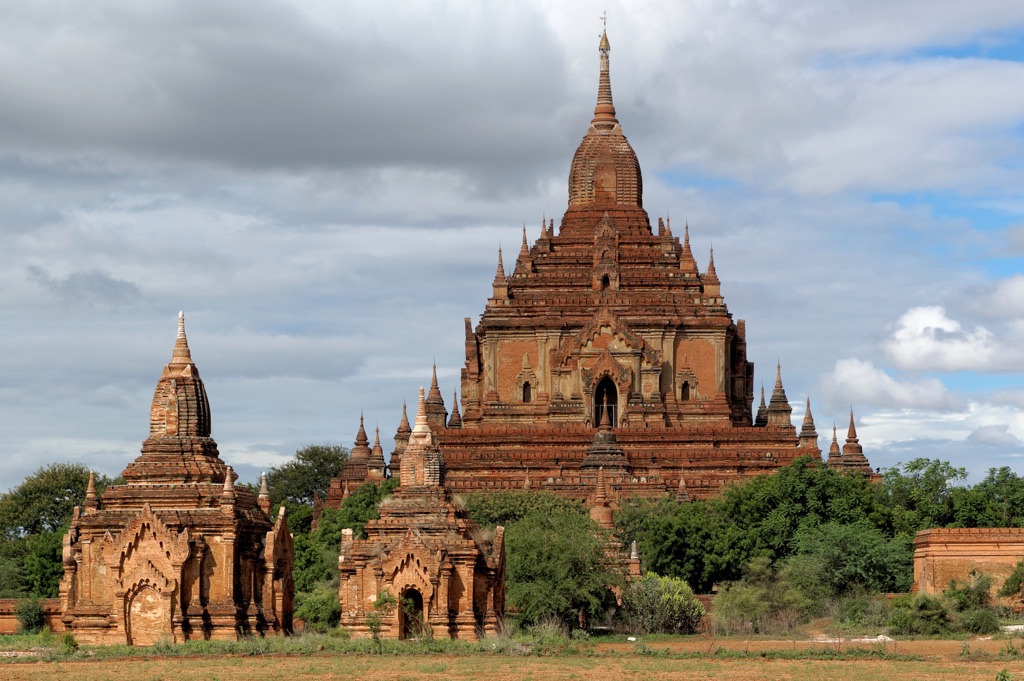The Htilominlo Temple stands as a testament to the architectural prowess of the Bagan civilization in Myanmar. Built during the reign of King Htilominlo, also known as Nandaungmya, it dates back to the early 13th century. This majestic structure is renowned for its intricate plaster carvings and glazed sandstone decorations. It is one of the larger temples in Bagan and has survived numerous earthquakes, retaining much of its original grandeur. The temple’s name, Htilominlo, is derived from the king’s nickname, meaning “the umbrella of the three worlds.”
Get your dose of History via Email
Historical Background of Htilominlo Temple
King Htilominlo, who ruled from 1211 to 1230, commissioned the Htilominlo Temple. Legend has it that he was chosen as king among his five brothers while standing under a white umbrella. The temple was built on the spot where this selection occurred. It was one of the last Myanmar-style temples built before the area transitioned to a different architectural style.
The temple’s construction began in 1211 and was completed in 1218. It stands as a symbol of the king’s religious devotion and his kingdom’s prosperity. The temple has been well-preserved, allowing visitors to appreciate its historical significance. Over the centuries, it has withstood invasions and natural disasters, including the 1975 earthquake that damaged many of Bagan’s monuments.
Htilominlo Temple was not just a religious site but also a center for scholarly learning. Monks and scholars once inhabited its chambers. The temple’s murals, which depict scenes from the Jataka tales and the life of the Buddha, are among the finest in Bagan.
The temple has not been the scene of any major historical events since its construction. However, it remains an important part of Bagan’s cultural heritage. It is a popular site for both pilgrims and tourists, who come to marvel at its beauty and historical significance.
The discovery of the temple’s historical importance is not attributed to a single individual. Instead, it has been part of the collective knowledge of the people of Myanmar. Archaeologists and historians have studied the temple extensively, contributing to our understanding of its place in Bagan’s history.
About Htilominlo Temple
Htilominlo Temple is a three-story structure standing at 46 meters high. It is built with red brick and features fine plaster carvings and glazed sandstone decorations. The temple’s design follows traditional Bagan architecture, with a central sanctuary and four Buddhas facing each cardinal direction.
The temple’s construction involved the use of bricks and stone, materials commonly used in Bagan’s temples. Craftsmen employed mortar, and the bricks were laid without the use of plaster in some sections, showcasing their skill. The temple’s outer walls are thick, providing stability and cool interiors.
Architectural highlights include the temple’s stucco carvings, which are among the best preserved in Bagan. The carvings depict ogresses, mythological beings, and scenes from the Buddha’s life. The temple’s interior walls were once adorned with frescoes, though many have faded over time.
The temple’s spire, or sikhara, is a prominent feature, visible from much of the Bagan plain. The sikhara, along with the temple’s other architectural elements, reflects the syncretism of Hindu and Buddhist beliefs that characterized the Bagan period.
The temple’s construction methods and materials have been studied to understand more about Bagan’s building techniques. The use of brick and stone, along with the architectural design, provides insights into the technological capabilities of the Bagan civilization.
Theories and Interpretations
The Htilominlo Temple’s purpose is widely believed to be religious. It served as a place of worship and a repository for sacred texts. The temple’s design and orientation are thought to have astrological significance, aligning with the cosmos.
Some theories suggest that the temple’s murals and carvings contain esoteric knowledge. Scholars have attempted to interpret these symbols to gain insights into the religious and philosophical beliefs of the time.
The mysteries surrounding the temple include the exact reasons for its construction. While it is clear that it was built to honor King Htilominlo’s reign, the choice of location and design may hold deeper meanings that are yet to be fully understood.
Historians have matched the temple’s architectural features with historical records to confirm its age and origin. The temple’s construction period is well-documented, providing a clear timeline for its creation.
Dating of the temple has been carried out using architectural analysis and comparison with other structures from the same period. The methods used to date the temple help to place it within the broader context of Bagan’s history.
At a glance
Country; Myanmar
Civilization; Bagan
Age; Built in 1211-1218 AD
Conclusion and Sources
The Htilominlo Temple is a significant historical and cultural monument in Myanmar. It reflects the architectural and artistic achievements of the Bagan civilization. The temple’s preservation allows for ongoing study and appreciation of this period in Myanmar’s history.
Reputable sources used in the creation of this article include;

